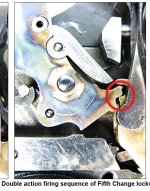I bought this 66 new a few years ago. I feel like I faintly remember it also having this little catch but thought it would work itself out. The catch in particular is in the area of timing of the first 1/8th of the trigger pull. It feels like the gun is having a hard time popping over and clearing the cylinder stop. When going really slow it feels like you are coming up against a wall until enough pressure builds that it finally releases into a smooth trigger pull the rest of the way. If you work the double action quickly you dont feel it so much. Manually cocking the hammer I do not feel it at all.
Few years later and several thousands of rounds and many more dry fires and its still present.
First time I popped it open to have a look I noticed that the trigger had cut a spot into the cylinder stop where it pops over. Figured this was for sure what I was feeling.
Replaced the cylinder stop. Still no joy and I still have the little catch.
I then polished a few spots like the trigger slide and its contact areas.
The catch remains.
I have now replaced the trigger( as I thought it maybe out of spec since it wore a hole in the originally cylinder stop), the hand, another cylinder stop, the mainspring and the cylinder stop spring
This catch is still there.
I have some hammer shims showing up today as I did note some heavy wear on the top side of the hammer where it would rub against the frame. It does have a little side to side play.
If the shims dont fix this then Im honestly at a loss. Nothing is sticking out as the obvious issue.
I probably have 6 or 7 smiths now and this is the only one that has this little catch in the trigger pull. All the rest are smooth the entire way through.
Any ideas?
Few years later and several thousands of rounds and many more dry fires and its still present.
First time I popped it open to have a look I noticed that the trigger had cut a spot into the cylinder stop where it pops over. Figured this was for sure what I was feeling.
Replaced the cylinder stop. Still no joy and I still have the little catch.
I then polished a few spots like the trigger slide and its contact areas.
The catch remains.
I have now replaced the trigger( as I thought it maybe out of spec since it wore a hole in the originally cylinder stop), the hand, another cylinder stop, the mainspring and the cylinder stop spring
This catch is still there.
I have some hammer shims showing up today as I did note some heavy wear on the top side of the hammer where it would rub against the frame. It does have a little side to side play.
If the shims dont fix this then Im honestly at a loss. Nothing is sticking out as the obvious issue.
I probably have 6 or 7 smiths now and this is the only one that has this little catch in the trigger pull. All the rest are smooth the entire way through.
Any ideas?
Last edited:





